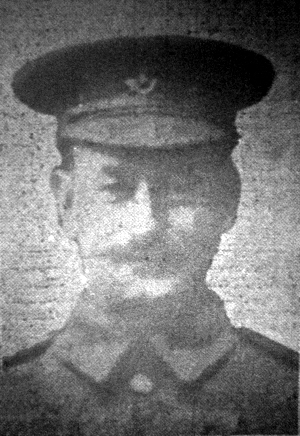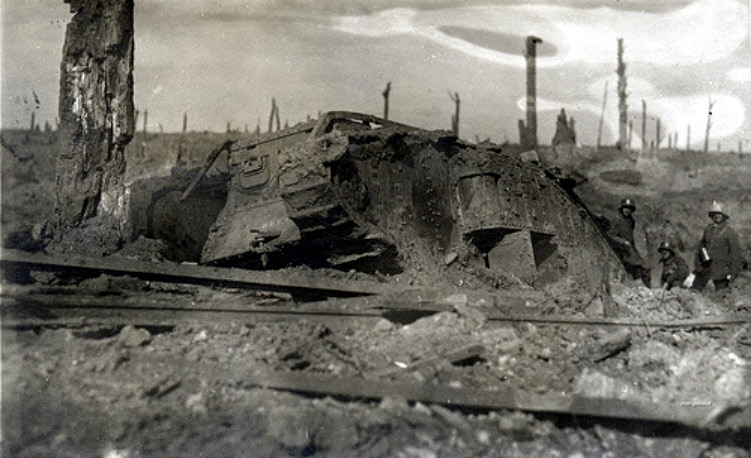
Thomas Grogan was born on the 25th January 1875 in Ballandine, Claremorris, Co. Mayo, Ireland, the son of Thomas Grogan and Julia Neilan. It is likely that he left Ireland in the early 1880s with his parents and siblings to live in Ossett.
His mother Julia died in Dewsbury district in 1887 and in 1891 Thomas (senior) and his six children: three girls and three boys, born between 1868 and 1879, all in Ireland, were living in a thriving Irish immigrant community on Storrs Hill Road, Ossett. Thomas Grogan (senior) worked as a general labourer. He died in Ossett in 1894 and is buried at Christ Church, South Ossett.
Thomas Grogan (junior) married Maria Callaghan in 1895 in Ossett and in 1901, the Grogan family are living in a two-roomed house, part of a terrace, at ‘Horbury Road, The Rocks’, which is now Sowood Avenue. There are two children: Oswald, born 1895 and a sister Julia, born in 1895. By 1911, the Grogan family has grown and there are two other children, Annie (7) and Tom (3), but a fifth child had died before 1911. They are now living in a two-roomed house at 20, Victoria Road, Dewsbury. Thomas Grogan was working as a hewer in a local coal mine.
Thomas Grogan’s son, Oswald Grogan, also lost his life during WW1 whilst fighting in Mesopotamia.
The 8th Battalion, King’s Own Yorkshire Light Infantry was raised at Pontefract in September 1914 as part of Kitchener’s Third New Army and joined 70th Brigade, 23rd Division. They undertook training in England at Pontefract, Frensham, Aldershot, Hythe and Bordon, before proceeding to France. They landed at Boulogne in August 1915. They transferred to with 70th Brigade to 8th Division on the 18th of October 1915, in an exchange with 24th Brigade, allowing the inexperienced troops to learn from those who had battle experience, returning to their original divisions in June 1916. The 23rd Division were at Bomy beginning a period of intensive training for the Battles of the Somme.
They were in action in The Battle of Albert including the capture of Contalmaison, The Battles of Bazentin Ridge, Pozieres, Flers-Courcelette, Morval and The Battle of Le Transloy including the capture of Le Sars. In 1917 they fought in The Battle of Messines, The Battles of the Menin Road, Polygon Wood and the The First and Second Battles of Passchendaele. In November 1917 the Division moved to Italy concentrating between Mantua and Marcaria before taking over the front line at the Montello on the 4th of December.
The regimental history of the KOYLI does not describe where the 8th Battalion was in August 1917. What was called The Flanders Offensive, or the Third Battle of Ypres, started on June 7th 1917 and lasted until November 10th 1917. It became associated with Passchendaele, but The First Battle of Passchendaele did not start until the 12th October 1917.
On the 23 August 1917, at 4:00 a.m. a German attack by the 34. Infanterie-Division, in the 14th Division (II corps) area, from Inverness Copse to Glencorse Wood with bombers (hand grenades) and flame-thrower units, pushed the British back to the line of the 22nd August between Inverness Copse and Glencorse Wood. Despite a German bombardment falling short on German troops in Inverness Copse, the infantry advanced, reached the western edge, then fell back still under fire from German artillery. Another attempt in the afternoon, under a hail of fire from both artilleries, pushed the British out of the Copse to the western fringe, from the Menin road to the junction of Jargon Drive and a sunken road.1
Thomas Grogan was killed in heavy fighting in the area of Inverness Copse and Glencourse Wood, near Zillebeke in Belgium on the 25th August 1917. At 6.0 a.m. on the 25th August, the H.Q. 14 Division 41st Brigade relieved the H.Q. 43rd Brigade at Dormy House – just east of Zillebeke. Both the 41st and 42nd Brigades were expecting relief that night – but such was not to be. The Staff of the 70th Brigade, 23rd Division, had arrived early and all arrangements had been made for the relief when, at 3.30 p.m., orders were received from 2nd Corps that the relief was cancelled and that the 41st Brigade was to remain at the disposal of the 23rd Division and to take over the whole divisional front supported by two battalions of the 70th Brigade. Accordingly the 8th Bn. York and Lancaster Regiment arrived that night at Zillebeke Bund relieving the 8th Bn. 60th which returned to Chateau Segard and the 8th Bn. K.O.Y.L.I. went to Half Way House, a position facing the present Wulvestraat, north of Zillebeke.
The “Ossett Observer” 2 had this short obituary for Private Grogan:
“Father and Son Killed – Corporal Thomas Grogan (42), of the K.O.Y.L.I., whose widow and family reside at Brigg’s Old-row, Storrs-hill-road, South Ossett, has fallen in recent fighting. His son, Lance-Corporal Oswald Grogan was killed in Mesopotamia in April last year. The father was one of the men who joined the army in response to Lord Kitchener’s appeal at the outbreak of the war, and according to an intimation received from the War Office, he was killed in action on August 25th last. About a year ago he suffered from a bullet wound in the shoulder, and was in hospital for some time. He was well-known in South Ossett.”

Above: British Mk IV tank with German soldiers, abandoned in Inverness Copse on the 22nd August 1917
Thomas Grogan’s army service file has not survived, but his medal card records that he embarked for France on the 11th September 1915 and thereby qualified for the 1914-15 Star in addition to the British and Victory medals.
Private Thomas Grogan was killed in action on the 25th August 1917, aged 42 years, and is buried at grave reference II. B. 38. at the Perth Cemetery (China Wall), 3 Ieper, West-Vlaanderen, Belgium. Perth Cemetery (China Wall) is located 3 Kms east of Ieper town centre, on the Maaldestedestraat, a road leading from the Meenseweg (N8), connecting Ieper to Menen.
The cemetery was begun by French troops in November 1914 (the French graves were removed after the Armistice) and adopted by the 2nd Scottish Rifles in June 1917. It was called Perth (as the predecessors of the 2nd Scottish Rifles were raised in Perth), China Wall (from the communication trench known as the Great Wall of China), or Halfway House Cemetery. The cemetery was used for front line burials until October 1917 when it occupied about half of the present Plot I and contained 130 graves. It was not used again until after the Armistice, when graves were brought in from the battlefields around Ypres and from several smaller cemeteries nearby.
There are now 2,791 Commonwealth servicemen of the First World War buried or commemorated in this cemetery. 1,369 of the burials are unidentified and special memorials are erected to 27 casualties known or believed to be buried among them. Other special memorials bear the names of 104 casualties buried in the cemeteries concentrated here, whose graves could not be found.
CWGC heastone photograph courtesy of Mark Smith
References:
1. Gott Mit Uns! German Military History 1848 – 1945
2. “Ossett Observer”, 29th September 1917